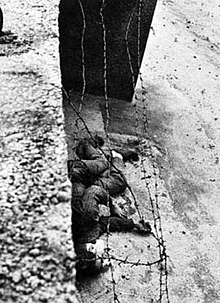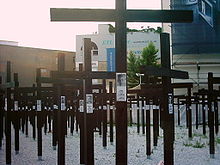Killing of Peter Fechter
This article needs additional citations for verification. (February 2013) |
Peter Fechter | |
|---|---|
 | |
| Born | 14 January 1944 |
| Died | 17 August 1962 (aged 18) Border Strip near Friedrich/Zimmerstrasse border crossing Checkpoint Charlie, East Berlin, East Germany |
| Cause of death | Shot by a guard without warning while attempting to leave East Berlin |
| Body discovered | Zimmerstrasse Death Strip 52°30′28″N 13°23′37″E / 52.5078°N 13.3935°E |
| Monuments | Peter Fechter memorial |
| Known for | One of the first and youngest fatalities and denied medical aid at the Berlin Wall |
Peter Fechter (14 January 1944 – 17 August 1962) was a German bricklayer who became the twenty-seventh known person to die at the Berlin Wall. Fechter was 18 years old when he was shot and killed by East German border guards while trying to cross over to West Berlin.
Biography
Peter Fechter was born on 14 January 1944, in
Death

On 17 August 1962, around one year after the construction of the Berlin Wall, Fechter and Helmut Kulbeik attempted to flee from East Germany. The plan was to hide in a
Their plan was initially successful as both Fechter and Kulbeik reached the final wall, but as they began to climb the
Trial
In March 1997, seven years after the
Commemoration


A cross was placed on the western side near the spot where Fechter was shot and bled to death. At the invitation of
The story of Peter Fechter was the headline of American news magazine Time in August 1962.[6] In this article was used the noun "Wall of Shame" (Mauer der Schande), and this became a synonym for the wall.[7]

After German reunification in 1990, the Peter-Fechter-Stelle memorial was constructed on Zimmerstraße, at the precise spot where he had died on the Eastern side, and this has been a focal point for some of the commemorations regarding the wall.[8] The shooting has also been the subject of documentaries on German television. Cornelius Ryan dedicated his book The Last Battle to the memory of Fechter. Composer Aulis Sallinen wrote an orchestral work Mauermusik to commemorate Fechter. In 2007, artist Mark Gubb was commissioned by the Institute of Contemporary Arts to create a performance[9] based on the death of Peter Fechter. The performance was a one-hour live piece that was later recorded and screened at the ICA with a discussion panel at the end consisting of the artist, and actor Dominik Danielewicz who played the part of Peter Fechter. The 1972 ballad Libre ("Free") – a recording famous in all Ibero-America – by Spanish singer Nino Bravo, remembers this event.[10] In 2012 Canadian playwright Jordan Tannahill's play Peter Fechter: 59 Minutes, a poetic re-imagining of the final hour of Fechter's life, was produced in Canada and Berlin.[11]
Literature
- Christine Brecht: Peter Fechter, in: Die Todesopfer an der Berliner Mauer 1961–1989. Ein biographisches Handbuch. Links, Berlin 2009, ISBN 978-3-86153-517-1, S. 101–104.
- Lars-Broder Keil, ISBN 978-3-86995-042-6.
- Ralf Gründer: SED-Mordopfer Peter Fechter, in: Niemand hat die Absicht .... Screenshot-Fotografie von Herbert Ernst, gedreht in den Jahren 1961 und 1962 im geteilten Berlin. Berliner Wissenschafts-Verlag, Berlin 2018, ISBN 978-3-8305-3673-4, S. 342–369.
- Jordan Tanahill: Peter Fechter: 59 Minutes, in: Age of Minority. Toronto 2013, ISBN 978-1-77091-194-9
.
See also
- List of deaths at the Berlin Wall
- Berlin Crisis of 1961
- Eastern Bloc emigration and defection
- List of Eastern Bloc defectors
- Libre (Nino Bravo song)
- Filmaufnahme vom Abtransport des sterbenden Peter Fechter
References
- ^ a b Wirth, Jennifer (1 September 2016). "This East Berliner Tried To Make A Run For Freedom, But Was Shot And Left To Slowly Die". All Day. Archived from the original on 28 May 2017. Retrieved 9 March 2017.
- ^ "Martyr at the Berlin Wall | HistoryNet". www.historynet.com.
- ^ "Otto Prokop: Wissenschaftler zwischen den Fronten" (in German).
- ^ Reports, Times Wire (6 March 1997). "2 Convicted in 1962 Berlin Wall Slaying". Los Angeles Times.
- ^ "Former East Germans Apologize For Killing Boy". tribunedigital-orlandosentinel.
- time.com. 31 August 1962. Archived from the originalon 17 January 2008.
- time.com. Archived from the originalon 4 March 2009.
- ^ Ahonen, Pertti. "Victims of the Berlin Wall". University of Edinburgh.
- ^ The Death of Peter Fechter film and discussion Archived 22 July 2011 at the Wayback Machine
- ^ "Libre: la triste historia detrás de una exitosa canción" (in Spanish). Retrieved 15 August 2016.
- ISBN 9781770911949
External links
 Media related to Peter Fechter at Wikimedia Commons
Media related to Peter Fechter at Wikimedia Commons- The Wall Comes Tumbling Down, excerpt from a biography of Leonard Bernstein at the Wayback Machine (archived 5 June 2008)
- Berlin Wall at Zimmerstrasse, Photos near the location of Fechter's death, taken in 1961
- ICA Performance, the performance and screening of the "Death of Peter Fechter"
- Jordan Tannahill: "Peter Fechter, 59 Minutes"
